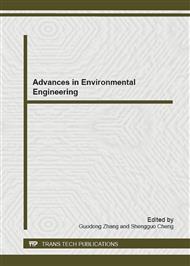p.358
p.363
p.367
p.372
p.378
p.383
p.387
p.391
p.395
Study on the Rehabilitation of Eutrophic Water by Bacillus–Matrix–Plant Integrated System
Abstract:
Abstract. Caisson, which is composed of box, matrix and plant, plays an important role in the removal of SRP (solubility reaction phosphorus), NH4+-N and CODCr in eutrophic water. Bacillus can improve water quality effectively. Bacillus and caisson combination can further improve purification efficiency of wastewater. In this study, bacillus was added to the caisson to purify the aquaculture ponds water and removal efficiency of SRP, NH4+-N, CODCr was analyzed. The results showed that bacillus adding proportion had bigger effects on the removal rate of SRP than those of the matrix material and plant collocation, while, the matrix material had more removal efficiency on NH4+-N and CODCr than the bacillus adding proportion and plant collocation. The removal rates of SRP, NH4+-N and CODCr in the wastewater treated with 1‰ and1.5‰ bacillus were significantly higher than 0.5‰, but no significant difference was observed between1‰ and 5‰ bacillus treatments; among the three matrices of limestone, ceramsite and medical stone, the removal rate of SRP was highest in the treatment with medical stone, while the removal rates of NH4+-N and CODCr was highest in the treatment with ceramsite; there were significant differences in the removal rates of SRP, NH4+-N and CODCr between different plant configurations. The removal rate of SRP was up to 80.73% by the combination of bacillus (1‰), limestone, Cyperus alternifolius and Iris pseudacorus; the removal rates of NH4+-N and CODCr were 63.63% and 63.45% by the combination of bacillus (1.5‰), ceramsite, Ceratophyllum demersum and Iris pseudacorus respectively.
Info:
Periodical:
Pages:
378-382
Citation:
Online since:
November 2012
Authors:
Keywords:
Price:
Сopyright:
© 2012 Trans Tech Publications Ltd. All Rights Reserved
Share:
Citation:


